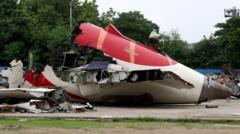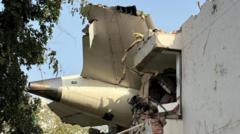As Air India grapples with the aftermath of the devastating crash that took 270 lives, experts warn that the airline's ambitious recovery strategy may now face serious setbacks due to declining passenger confidence and looming investigations.
Air India's Road to Recovery Stalled by Tragic Crash

Air India's Road to Recovery Stalled by Tragic Crash
Investigation into devastating AI-171 crash raises doubts on Air India's turnaround plans.
Days after the shocking crash of Air India flight AI-171, which claimed at least 270 lives, a comprehensive investigation is underway involving international experts aiming to determine the cause of this tragedy. The Tata Group, which owns the airline, is now confronted with numerous challenges that threaten to derail its ambitious recovery plans. Just prior to the incident, Air India had initiated a resurgence under new private ownership. The Tata Group acquired the airline in 2022, and there were promising signs of profitability and improvements in service quality. With reduced customer complaints and a more robust financial outlook, Air India seemed to be on the path to revitalization after years of neglect under state guidance.
Cosmetic changes were also evident; the airline introduced an updated livery and began integrating new A-350 aircraft into its operations. However, the tragic crash has cast a dark shadow on these advancements and shattered the growing optimism surrounding Air India.
Public sentiment has already shifted dramatically, with passengers expressing doubt and fear about flying the carrier again. Experts note that although Air India has maintained a commendable safety record in the past, such a significant incident is likely to provoke immediate distrust among travelers. This could severely hamper ongoing recovery efforts and potentially lead to a slump in bookings, further complicating the airline's transition.
Recent incidents, including engine issues on flights and an unrelated bomb hoax, add to the airline’s woes and contribute to public skepticism. "The tragic event will linger in memories, and we are likely to see immediate impacts on cancellations," said industry analyst Shukor Yusof. Air India's efforts to reinvent itself may also be interrupted as resources are redirected toward managing the fallout from the crash, including legal and reputational concerns.
Comparisons have been drawn to Malaysia Airlines, which struggled to regain profitability in the wake of its own crises in 2014. Experts predict that Air India might similarly require extensive time to recover and reinforce its operational strategies. Already, the airline announced a 15% reduction in services on international routes as it implements enhanced safety checks.
The global scrutiny surrounding the investigation will also keep Air India under intense pressure as regulatory bodies from the UK, US, and India examine various facets of the airline’s operations and safety protocols. Experts emphasize the need for Air India to implement corrective measures while maintaining clear and consistent communication with the public to restore its reputation.
Tata Group Chairman N. Chandrasekaran is actively engaging with employees, urging resilience amidst the crisis. CEO Campbell Wilson has committed to cooperating fully with investigators and supporting affected families. As the airline strengthens its protocols in response to this catastrophe, reliance on partners like Singapore Airlines may offer additional pathways for recovery.
While the road ahead is fraught with challenges, Air India's leadership aims to utilize this difficult period to cement its commitment to safety and modernization, striving to emerge from this crisis reinforced and revitalized.
Cosmetic changes were also evident; the airline introduced an updated livery and began integrating new A-350 aircraft into its operations. However, the tragic crash has cast a dark shadow on these advancements and shattered the growing optimism surrounding Air India.
Public sentiment has already shifted dramatically, with passengers expressing doubt and fear about flying the carrier again. Experts note that although Air India has maintained a commendable safety record in the past, such a significant incident is likely to provoke immediate distrust among travelers. This could severely hamper ongoing recovery efforts and potentially lead to a slump in bookings, further complicating the airline's transition.
Recent incidents, including engine issues on flights and an unrelated bomb hoax, add to the airline’s woes and contribute to public skepticism. "The tragic event will linger in memories, and we are likely to see immediate impacts on cancellations," said industry analyst Shukor Yusof. Air India's efforts to reinvent itself may also be interrupted as resources are redirected toward managing the fallout from the crash, including legal and reputational concerns.
Comparisons have been drawn to Malaysia Airlines, which struggled to regain profitability in the wake of its own crises in 2014. Experts predict that Air India might similarly require extensive time to recover and reinforce its operational strategies. Already, the airline announced a 15% reduction in services on international routes as it implements enhanced safety checks.
The global scrutiny surrounding the investigation will also keep Air India under intense pressure as regulatory bodies from the UK, US, and India examine various facets of the airline’s operations and safety protocols. Experts emphasize the need for Air India to implement corrective measures while maintaining clear and consistent communication with the public to restore its reputation.
Tata Group Chairman N. Chandrasekaran is actively engaging with employees, urging resilience amidst the crisis. CEO Campbell Wilson has committed to cooperating fully with investigators and supporting affected families. As the airline strengthens its protocols in response to this catastrophe, reliance on partners like Singapore Airlines may offer additional pathways for recovery.
While the road ahead is fraught with challenges, Air India's leadership aims to utilize this difficult period to cement its commitment to safety and modernization, striving to emerge from this crisis reinforced and revitalized.






















